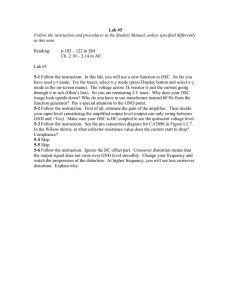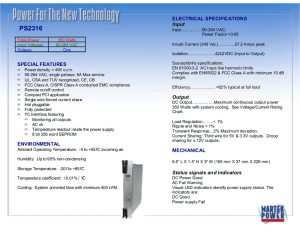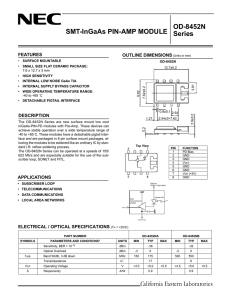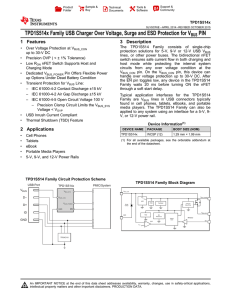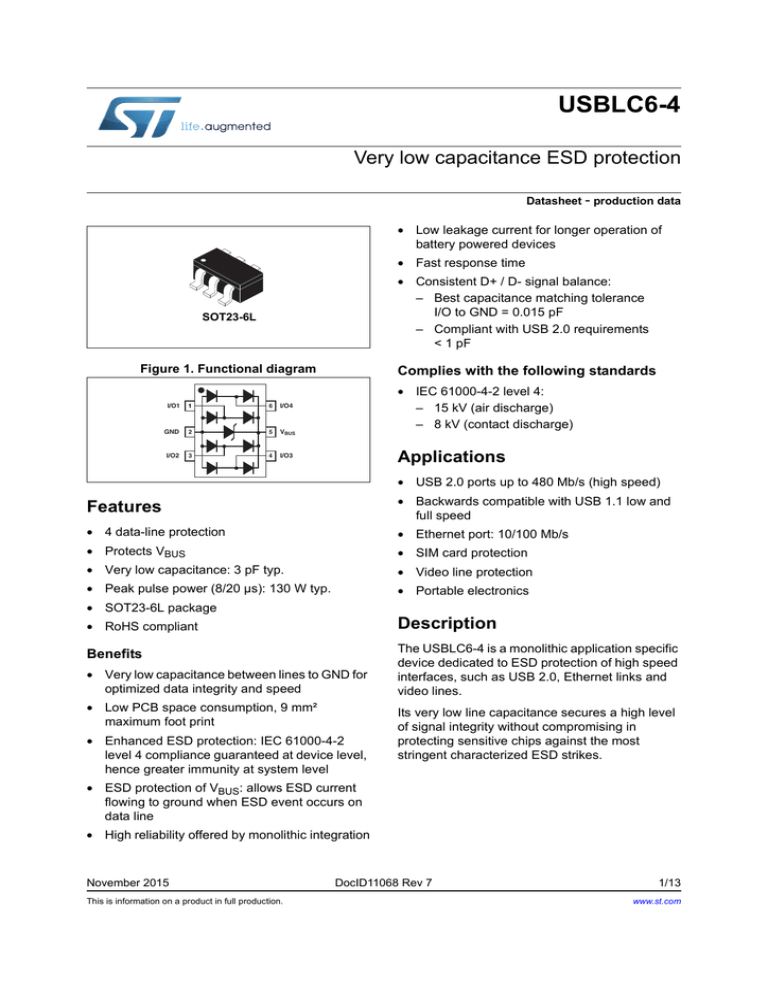
USBLC6-4
Very low capacitance ESD protection
Datasheet - production data
• Low leakage current for longer operation of
battery powered devices
• Fast response time
• Consistent D+ / D- signal balance:
– Best capacitance matching tolerance
I/O to GND = 0.015 pF
– Compliant with USB 2.0 requirements
< 1 pF
SOT23-6L
Figure 1. Functional diagram
I/O1
1
1
6
I/O4
GND
2
5
VBUS
I/O2
3
4
I/O3
Complies with the following standards
• IEC 61000-4-2 level 4:
– 15 kV (air discharge)
– 8 kV (contact discharge)
Applications
• USB 2.0 ports up to 480 Mb/s (high speed)
Features
• Backwards compatible with USB 1.1 low and
full speed
• 4 data-line protection
• Ethernet port: 10/100 Mb/s
• Protects VBUS
• SIM card protection
• Very low capacitance: 3 pF typ.
• Video line protection
• Peak pulse power (8/20 µs): 130 W typ.
• Portable electronics
• SOT23-6L package
• RoHS compliant
Description
Benefits
The USBLC6-4 is a monolithic application specific
device dedicated to ESD protection of high speed
interfaces, such as USB 2.0, Ethernet links and
video lines.
• Very low capacitance between lines to GND for
optimized data integrity and speed
• Low PCB space consumption, 9 mm²
maximum foot print
• Enhanced ESD protection: IEC 61000-4-2
level 4 compliance guaranteed at device level,
hence greater immunity at system level
Its very low line capacitance secures a high level
of signal integrity without compromising in
protecting sensitive chips against the most
stringent characterized ESD strikes.
• ESD protection of VBUS: allows ESD current
flowing to ground when ESD event occurs on
data line
• High reliability offered by monolithic integration
November 2015
This is information on a product in full production.
DocID11068 Rev 7
1/13
www.st.com
Characteristics
1
USBLC6-4
Characteristics
Table 1. Absolute ratings
Symbol
Parameter
IEC 61000-4-2 air discharge
IEC 61000-4-2 contact discharge
MIL STD883C-Method 3015-6
Value
Unit
15
15
25
kV
VPP
Peak pulse voltage
Tstg
Storage temperature range
-55 to +150
°C
Tj
Operating junction temperature range
-40 to +125
°C
TL
Lead solder temperature (10 seconds duration)
260
°C
Table 2. Electrical characteristics (Tamb = 25 °C)
Value
Symbol
Parameter
Test Conditions
Unit
Min.
Typ.
Max.
10
150
nA
10
V
0.86
V
IPP = 1 A, 8/20 µs
Any I/O pin to GND
12
V
IPP = 5 A, 8/20 µs
Any I/O pin to GND
17
V
IRM
Leakage current
VRM = 5.25 V
VBR
Breakdown voltage
between VBUS and GND
IR = 1 mA
Forward voltage
IF = 10 mA
VF
VCL
Ci/o-GND
Clamping voltage
Capacitance between I/O
VR = 1.65 V
and GND
ΔCi/o-GND
Ci/o-i/o
3
4
pF
0.015
Capacitance between I/O VR = 1.65 V
ΔCi/o-i/o
2/13
6
1.85
pF
0.04
DocID11068 Rev 7
2.7
USBLC6-4
Characteristics
Figure 2. Capacitance versus voltage
(typical values)
Figure 3. Line capacitance versus frequency
(typical values)
C(pF)
C(pF)
5.0
5.0
F=1MHz
VOSC=30mVRMS
Tj=25°C
4.5
4.0
VOSC=30mVRMS
Tj=25°C
4.5
VCC=0V
4.0
3.5
3.5
CO=I/O-GND
VCC=1.65V
3.0
3.0
2.5
2.5
Cj=I/O-I/O
2.0
2.0
1.5
1.5
1.0
1.0
0.5
0.5
Data line voltage (V)
0.0
F(MHz)
0.0
0.0
0.5
1.0
1.5
2.0
2.5
3.0
3.5
4.0
4.5
5.0
1
10
Figure 4. Relative variation of leakage current
versus junction temperature (typical values)
1000
Figure 5. Frequency response
IRM[Tj] / IRM[Tj=25°C]
0.00
100
100
S21(dB)
VBUS=5V
-5.00
-10.00
10
-15.00
F(Hz)
Tj(°C)
1
-20.00
25
50
75
100
125
100.0k
DocID11068 Rev 7
1.0M
10.0M
100.0M
1.0G
3/13
13
Technical information
USBLC6-4
2
Technical information
2.1
Surge protection
The USBLC6-4SC6 is particularly optimized to provide surge protection based on the rail to
rail topology.
The clamping voltage VCL can be calculated as follows:
VCL+ = VTRANSIL + VF for positive surges
VCL- = - VF for negative surges
with: VF = VT + Rd.Ip
(VF forward drop voltage, VT forward drop threshold voltage
Calculation example
We assume that the value of the dynamic resistance of the clamping diode is typically:
Rd = 0.5 Ω and VT = 1.1 V.
For an IEC 61000-4-2 surge level 4 (Contact Discharge: Vg = 8 kV, Rg = 330 Ω),
VBUS = +5 V, and if in a first approximation, we assume that:
Ip = Vg / Rg = 24 A.
So, we find:
VCL+ = +31.2 V
VCL- = -13.1 V
Note:
The calculations do not take into account phenomena due to parasitic inductances.
2.2
Surge protection application example
If we consider that the connections from the pin VBUS to VCC, from I/O to data line and from
GND to PCB GND plane are implemented as racks 10 mm long and 0.5 mm large, we can
assume that the parasitic inductances LVBUS LI/0 and LGND of these tracks are about 6 nH.
So, when an IEC 61000-4-2 surge occurs, due to the rise time of this spike (tr = 1 ns), the
voltage VCL has an extra value equal to LI/0·dI/dt, + LGND·dI/dt
The dI/dt is calculated as:
dI/dt = Ip/tr = 24 A/ns
The overvoltage due to the parasitic inductances is:
LI/0·dI/dt, = LGND·dI/dt = 6 x 24 = 144 V
By taking into account the effect of these parasitic inductances due to unsuitable layout, the
clamping voltage will be:
VCL+ = +31.2 + 144 + 144 = 319.2 V
VCL- = -13.1 - 144 -144 = -301.1 V
We can significantly reduce this phenomena with simple layout optimization. It is for this
reason that some recommendations have to be followed (see 2.3: How to ensure good ESD
protection).
4/13
DocID11068 Rev 7
USBLC6-4
Technical information
Figure 6. ESD behavior: parasitic phenomena due to unsuitable layout
ESD sur ge on data line
VCL+
VBUS
Data line
L I/O di
dt
L I/O
L I/O di + L GND di
dt
dt
L VBUS
Positive
Sur ge
VCC pin
VF
VTRANSIL
I/O pin
VTRANSIL + VF
VCL
t
t r = 1 ns
GND pin
t r = 1 ns
L GND
L GND di
dt
t
- VF
VCL + = VTRANSIL + VF + L I/O di + L GND di
dt
dt
sur ge > 0
VCL- = -VF - L I/O di - L GND di
dt
dt
sur ge > 0
Negative
Sur ge
-L I/O di - L GND di
dt
dt
V TRANSIL = VBR + Rd.Ip
VCL-
2.3
How to ensure good ESD protection
While the USBLC6-4SC6 provides high immunity to ESD surge, efficient protection depends
on the layout of the board. In the same way, with the rail to rail topology, the track from data
lines to I/O pins, from VCC to the VBUS pin and from GND plane to GND pin must be as short
as possible to avoid overvoltages due to parasitic phenomena (see Figure 7 and Figure 8
for layout considerations)
Figure 7. ESD behavior: optimized layout and
addition of a capacitance of 100 nF
Figure 8. ESD behavior: measurement
conditions (with coupling capacitance)
ESD SURGE
TEST BOARD
Unsuitable layout
IN
OUT
USBLC6-4SC6
Vbus
Optimized layout
DocID11068 Rev 7
5/13
13
Technical information
USBLC6-4
Figure 9. Remaining voltage after the USBLC6- Figure 10. Remaining voltage after the USBLC64SC6 during positive ESD surge
4SC6 during negative ESD surge
Note:
The measurements have been done with the USBLC6-4SC6 in open circuit.
Important:
A good precaution to take is to put the protection device as close as possible to the
disturbance source (generally the connector).
2.4
Crosstalk behavior
2.4.1
Crosstalk phenomenon
Figure 11. Crosstalk phenomenon
RG1
Line 1
VG1
RL1
RG2
α 1 VG1 + β12VG2
Line 2
VG2
RL2
DRIVERS
α 2VG2 + β21VG1
RECEIVERS
The crosstalk phenomenon is due to the coupling between 2 lines. The coupling factor (β12
or β21) increases when the gap across lines decreases, particularly in silicon dice. In the
above example the expected signal on load RL2 is α2VG2, in fact the real voltage at this
point has got an extra value β21VG1. This part of the VG1 signal represents the effect of the
crosstalk phenomenon of the line 1 on the line 2. This phenomenon has to be taken into
account when the drivers impose fast digital data or high frequency analog signals in the
disturbing line. The perturbed line will be more affected if it works with low voltage signal or
high load impedance (few kΩ).
6/13
DocID11068 Rev 7
USBLC6-4
Technical information
Figure 12. Analog crosstalk measurements
USBLC6-4SC6
TEST BOARD
NETWORK ANALYSER
PORT 1
NETWORK ANALYSER
PORT 2
Vbus
Figure 12. shows the measurement circuit for the analog application. In usual frequency
range of analog signals (up to 240 MHz) the effect on disturbed line is less than -55 dB (see
Figure 13.).
Figure 13. Analog crosstalk results
0.00
dB
- 30.00
- 60.00
- 90.00
F (Hz)
- 120.00
100.0k
1.0M
10.0M
f/Hz
100.0M
1.0G
As the USBLC6-4SC6 is designed to protect high speed data lines, it must ensure a good
transmission of operating signals. The frequency response (Figure 5.) gives attenuation
information and shows that the USBLC6-4SC6 is well suitable for data line transmission up
to 480 Mbit/s while it works as a filter for undesirable signals like GSM (900 MHz)
frequencies, for instance.
DocID11068 Rev 7
7/13
13
Technical information
2.5
USBLC6-4
Application examples
Figure 14. USB 2.0 port application diagram using USBLC6-4SC6
+ 3.3V
DEVICEUPSTREAM
RPU
TRANSCEIVER
SW2
+ 5V
USB
connector
SW1
VBUS
RX LS/FS +
RX HS +
TX HS +
RX LS/FS RX HS TX HS GND
TX LS/FS +
TX LS/FS -
Protecting
Bus Switch
VBUS
RX LS/FS +
RX HS +
TX HS +
RX LS/FS RX HS TX HS -
VBUS
D+
DRS
USBLC6-2SC6
GND
RS
RS
RS
RPD
+ 3.3V
DEVICEUPSTREAM
RPU
TRANSCEIVER
SW2
TX LS/FS -
RX LS/FS +
RX HS +
TX HS +
RX LS/FS RX HS TX HS -
D+
DRS
USBLC6-2P6
GND
RS
USBLC6-4SC6
RS
Mode
SW1
SW2
Low Speed LS
Open
Closed
Full Speed FS
Closed
Open
High Speed HS
Closed then open Open
RS
Figure 15. T1/E1/Ethernet protection
Tx
100nF
USBLC6-4SC6
SMP75-8
+VCC
Rx
SMP75-8
DocID11068 Rev 7
GND
TX LS/FS +
RPD
8/13
TX LS/FS -
RPD
VBUS
TX LS/FS +
GND
TX LS/FS +
USB
connector
SW1
VBUS
RX LS/FS +
RX HS +
TX HS +
RX LS/FS RX HS TX HS GND
HUBDOWNSTREAM
TRANSCEIVER
DATA
TRANSCEIVER
RPD
TX LS/FS -
USBLC6-4
2.6
Technical information
PSPICE model
Figure 16. shows the PSPICE model of one USBLC6-4SC6 cell. In this model, the diodes
are defined by the PSPICE parameters given in Figure 17.
Figure 16. PSPICE model
MODEL = Dlow
LIO
MODEL = Dhigh
RIO
RIO
io1
LIO
io4
MODEL = Dlow
LGND
RGND
MODEL = Dhigh
MODEL = Dzener
RIO
LIO
GND
VBUS
MODEL = Dlow
LIO
MODEL = Dhigh
RIO
RIO
io2
LIO
io3
MODEL = Dlow
Note:
MODEL = Dhigh
This simulation model is available only for an ambient temperature of 27 °C.
Figure 17. PSPICE parameters
Dlow
Dhigh
BV
50
50
7.3
CJ0
2.4p
2.4p
20p
Figure 18. USBLC6-4SC6 PCB layout
considerations
Dzener
IBV
1m
1m
1m
IKF
0.038
0.018
2.42
IS
55.2p
2.27f
3.21p
ISR
100p
100p
100p
N
1.62
1.13
1.24
M
0.3333
0.3333
0.3333
RS
0.38
0.63
0.42
VJ
0.6
0.6
0.6
TT
0.1u
0.1u
0.1u
D+1
LIO
710p
D-1
RIO
100m
GND
LGND
430p
D+2
RGND
50m
D-2
1
VBUS
CBUS = 100nF
USBLC6-4SC6
DocID11068 Rev 7
9/13
13
Ordering information scheme
3
USBLC6-4
Ordering information scheme
Figure 19. Ordering information scheme
USB
Product Designation
Low capacitance
Breakdown Voltage
6 = 6 Volts
Number of lines protected
4 = 4 lines
Package
SC6 = SOT23-6L
10/13
DocID11068 Rev 7
LC
6 - 4
SC6
USBLC6-4
4
Package information
Package information
•
Epoxy meets UL94, V0
•
Lead-free package
In order to meet environmental requirements, ST offers these devices in different grades of
ECOPACK® packages, depending on their level of environmental compliance. ECOPACK®
specifications, grade definitions and product status are available at: www.st.com.
ECOPACK® is an ST trademark.
Table 3. SOT23-6L package dimensions
Dimensions
Ref.
Millimeters
Min.
A1
c
q
L
H
A
E
e
b
D
e
Figure 20. SOT23-6L footprint (mm)
Max.
Min.
Typ.
Max.
A
0.90
A1
0
A2
0.90
1.30 0.035
0.051
b
0.35
0.50 0.014
0.02
C
0.09
0.20 0.004
0.008
D
2.80
3.05
0.110
0.120
E
1.50
1.75 0.059
0.069
e
A2
Typ.
Inches
1.45 0.035
0.057
0.10
0.004
0
0.95
0.037
H
2.60
3.00 0.102
0.118
L
0.10
0.60 0.004
0.024
θ
0°
10°
0°
10°
Figure 21. SOT23-6L marking
0.60
1.20
3.50
2.30
0.95
UL46
1.10
DocID11068 Rev 7
11/13
13
Ordering information
5
USBLC6-4
Ordering information
Table 4. Ordering information
6
Order code
Marking
Package
Weight
Base qty
Delivery mode
USBLC6-4SC6
UL46
SOT23-6L
16.7 mg
3000
Tape and reel
Revision history
Table 5. Document revision history
12/13
Date
Revision
Changes
10-Dec-2004
1
First issue.
28-Feb-2005
2
Minor layout update. No content change.
04-Feb-2008
3
Updated operating junction temperature range in absolute ratings,
page 2. Updated Section 2: Technical information. Updated marking
illustration Figure 21. Reformatted to current standard.
23-Sep-2011
4
Updated leakage current at VRM = 5.25 V as specified in USB
standard. Updated marking illustration Figure 21.
13-Oct-2015
5
Updated features in cover page and Table 2.
26-Oct-2015
6
Updated features in cover page.
03-Nov-2015
7
Minor text changes.
DocID11068 Rev 7
USBLC6-4
IMPORTANT NOTICE – PLEASE READ CAREFULLY
STMicroelectronics NV and its subsidiaries (“ST”) reserve the right to make changes, corrections, enhancements, modifications, and
improvements to ST products and/or to this document at any time without notice. Purchasers should obtain the latest relevant information on
ST products before placing orders. ST products are sold pursuant to ST’s terms and conditions of sale in place at the time of order
acknowledgement.
Purchasers are solely responsible for the choice, selection, and use of ST products and ST assumes no liability for application assistance or
the design of Purchasers’ products.
No license, express or implied, to any intellectual property right is granted by ST herein.
Resale of ST products with provisions different from the information set forth herein shall void any warranty granted by ST for such product.
ST and the ST logo are trademarks of ST. All other product or service names are the property of their respective owners.
Information in this document supersedes and replaces information previously supplied in any prior versions of this document.
© 2015 STMicroelectronics – All rights reserved
DocID11068 Rev 7
13/13
13




